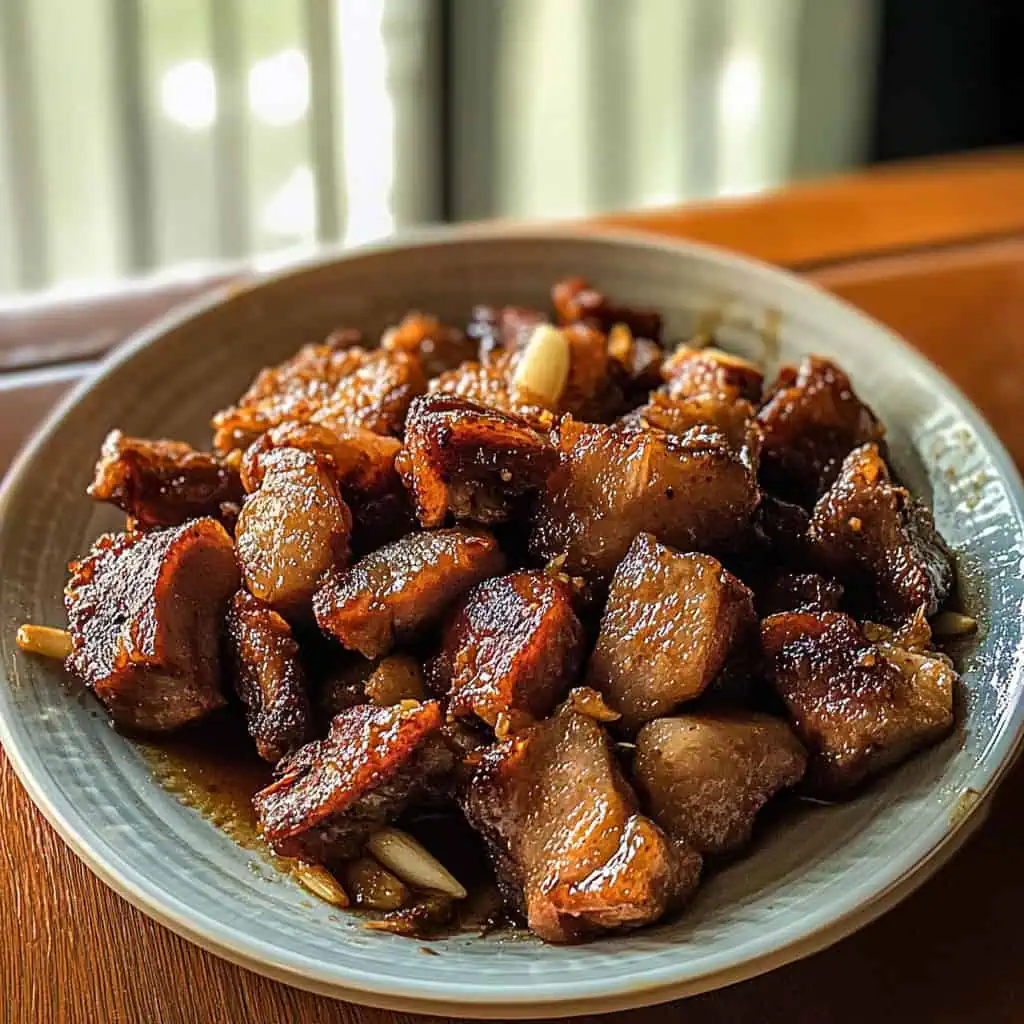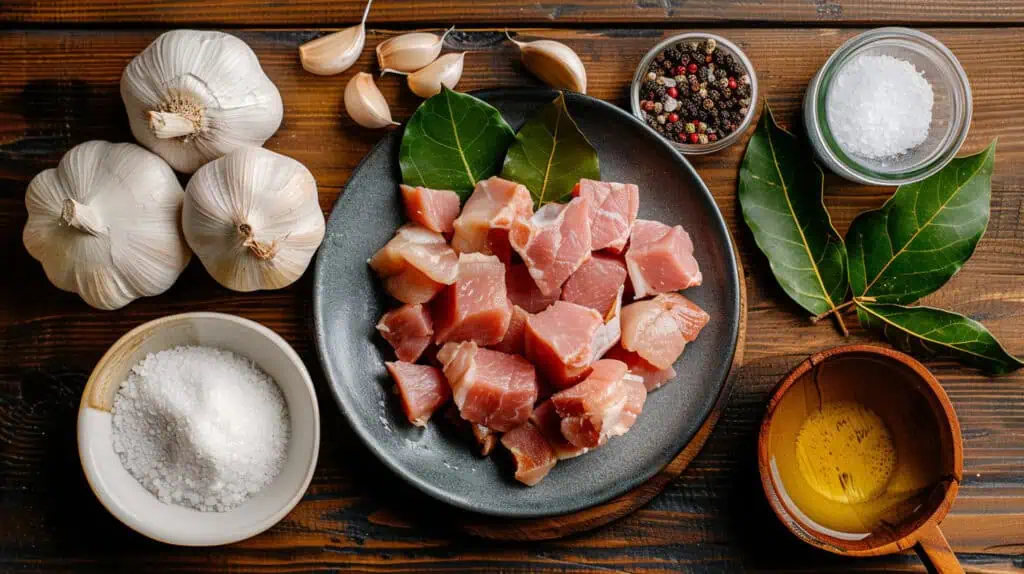Let me share a heartwarming secret from my kitchen: Adobo sa Asin, a beautiful twist on our beloved national dish.
While I've made countless pots of traditional adobo over the years (it was actually the first dish I learned to cook), discovering this "white adobo" during a trip to Bicol changed everything.
Instead of the familiar dark soy sauce-based version we all grew up with, this recipe relies on pure rock salt and plenty of garlic, letting the natural flavors of the pork belly shine through.
The way the meat gets slightly toasted, with those crispy edges and that sinful sauce from the rendered fat, it's absolutely divine with steaming white rice. It's simpler, but somehow even more special.
What is Adobo sa Asin?
Adobo sa Asin (White Adobo) is a pre-colonial Filipino dish where pork belly is slowly cooked in its own rendered fat with garlic, rock salt, and vinegar until tender inside and lightly crisped outside. Unlike the more common soy sauce-based adobo, this heritage version showcases the pure, concentrated flavors of the meat enhanced by salt and aromatics, resulting in a naturally preserved dish that develops deeper complexity over time.
Jump to:

Why You'll Love This Recipe
- Authentically Filipino: A pre-colonial cooking method that showcases our culinary heritage
- Simple Ingredients: Uses basic pantry staples found in every Filipino kitchen
- Better with Time: Flavors develop and improve over days
- Practical: Traditional preservation method means it keeps well
- Versatile: Perfect for multiple meals - from rice bowls to breakfast fried rice
Ingredients
This recipe uses simple, traditional ingredients that create deep flavor through careful technique. Pork belly provides rich fat that renders during cooking, becoming both the cooking medium and a key flavor component. The four whole heads of garlic might seem excessive, but they mellow dramatically during cooking, creating a sweet, aromatic base.
Rock salt is used instead of soy sauce to highlight the pork's natural flavor while preserving it the traditional way. White vinegar balances the richness and acts as a natural preservative, while whole peppercorns and bay leaves add subtle aromatic notes without overpowering the dish.
Together, these ingredients create a pure, concentrated version of adobo that lets the quality of the pork truly shine.

- 1 kilo pork belly, cut into 1-inch cubes
- 4 whole garlic heads, minced
- 2-3 tablespoons rock salt
- ¼ cup white vinegar
- 1 cup water
- 1 tablespoon whole black peppercorns
- 2-3 bay leaves
Equipment
- Kawali or Deep Frying Pan: For even heat distribution and proper meat browning. The traditional Filipino wok shape helps with evaporation and concentrating flavors.
- Sharp Knife & Cutting Board: Essential for cutting meat into uniform pieces, ensuring even cooking.
- Wooden Spoon: Best for stirring without scratching your pan and maintaining the integrity of the meat chunks.
- Heavy-Bottomed Pot: Optional but helpful if cooking larger quantities, as it retains heat well for slow cooking.
- Measuring Cups & Spoons: For precise ingredient proportions, especially important with salt and vinegar balance.

How To Make
- Start by patting dry 1 kilo of pork belly and cutting it into 1-inch cubes. Mince 4 whole heads of garlic. Set both aside.
- Place the pork cubes in a deep pan and add just enough water to cover the meat. Bring to a boil over medium-high heat and let the water evaporate completely, about 15-20 minutes.
- Once the water is gone, continue cooking the pork in its own rendered fat. Let the meat brown on all sides until slightly crispy, about 10-15 minutes. Remove the browned pork and set aside.
- Using the same pan with the pork fat, sauté the minced garlic until light golden and fragrant, about 2 minutes. Add 1 cup of water and a small pinch of rock salt.
- Return the browned pork to the pan. Pour in ¼ cup vinegar but don't stir – let it boil for 2 minutes first. Add 1 tablespoon whole peppercorns and 2-3 bay leaves.
- Reduce heat to low and simmer until the liquid reduces and the meat is tender, about 20-25 minutes. Add rock salt to taste. The sauce should be slightly thickened from the rendered fat.
- For extra-crispy meat, continue cooking until the pork starts to fry in its own fat again. Taste and adjust seasoning – it should be pleasantly salty with a subtle vinegar tang.
- Let rest for 10 minutes before serving with hot rice. Save any leftovers – this adobo tastes even better the next day.

Tips from Lola's Kitchen
- The Vinegar Secret: Never stir vinegar immediately after adding it - let it boil first for about 2 minutes to remove the raw taste and develop a more mellow flavor.
- Salt Selection Matters: Use rock salt instead of iodized salt for better flavor development and authentic taste. The minerals in rock salt enhance the meat's natural flavors.
- Temperature Technique: The meat should be room temperature before cooking for even browning and to prevent tough texture. Take it out of the refrigerator 30 minutes before cooking.
- Patience Pays Off: Don't rush the browning process - this develops the complex flavors that make this dish special. The caramelization is essential for depth.
- Save the Fat: The rendered pork fat is liquid gold - strain and save it in a jar for future cooking. It adds incredible flavor to fried rice and other Filipino dishes.
- Garlic Preparation Timing: Prepare garlic just before cooking to preserve its aromatic oils and maximize flavor impact.
- The Rest Period: Allowing the adobo to rest for 10 minutes before serving lets the flavors settle and the meat reabsorb some of the sauce.
Substitutions
- Meat Options: While pork belly is traditional, you can use chicken thighs (reduce cooking time to 35-40 minutes) or pork shoulder (increase cooking time by 15 minutes).
- Vinegar Varieties: White vinegar is standard, but apple cider vinegar or coconut vinegar offer subtle flavor variations. Palm vinegar works wonderfully if you can find it.
- Salt Alternatives: If rock salt isn't available, use sea salt but reduce the amount by 25% as it's more concentrated. Avoid table salt if possible.
- Garlic Substitute: In a pinch, you can use 2 tablespoons of garlic powder, but fresh garlic is strongly recommended for authentic flavor.
- Bay Leaf Options: If fresh bay leaves are available, use only 1-2 as they're more potent than dried ones.
Troubleshooting
Too Salty
- Add a splash of vinegar to balance the flavor
- Include quartered potatoes to absorb excess salt
- Add a small amount of water to dilute without losing flavor
Too Dry
- Add small amounts of water, a tablespoon at a time
- Lower heat during final cooking stage
- Cover partially with a lid to retain moisture
Meat Too Tough
- Cook longer on lower heat, adding 15-20 minutes
- Add small amounts of water as needed
- Check if your heat was too high during cooking
Not Enough Flavor
- Add more minced garlic mid-cooking
- Increase rock salt gradually, tasting as you go
- Allow to rest overnight - flavors develop with time
Too Sour
- Add a small pinch of sugar to balance acidity
- Cook longer to mellow the vinegar flavor
- Add more salt to counterbalance sourness
Storage & Reheating
Refrigerator Storage:
- Store in an airtight container for 5-7 days
- The flavor actually improves after 1-2 days of resting
- Keep meat and sauce together for best flavor preservation
Freezer Storage:
- Freezes well for up to 3 months in freezer-safe containers
- Freeze in meal-sized portions for convenient reheating
- Thaw completely in refrigerator before reheating
Reheating Methods:
- Stovetop (Recommended): Reheat on low heat with a splash of water, uncovered to allow excess moisture to evaporate
- Microwave: 2-3 minutes on medium power, stirring halfway through
- For best texture, reheat in a pan to re-crisp the meat edges
Serving After Storage:
- Skim solidified fat before reheating if desired
- Add fresh minced garlic when reheating for a flavor boost
- Let come to room temperature for 15 minutes before reheating for more even warming

FAQ
Can I make this ahead for a party?
Yes, it actually tastes better when made 1-2 days ahead. Store in the refrigerator and reheat slowly on the stovetop, adding a splash of water if needed. The flavors develop and deepen with time.
Why is my adobo not browning well?
Ensure the meat is completely dry before browning and don't overcrowd the pan. Cook in batches if necessary. Also, make sure all water has evaporated before the browning stage begins.
How do I know when it's done?
The meat should be fork-tender and the sauce should be reduced to a slightly thick glaze. The fat will have rendered, creating a rich, silky sauce. If you're unsure, taste a piece - it should be tender throughout with no resistance.
Can I use lean meat for this recipe?
Not recommended, as the fat adds essential flavor and prevents the meat from becoming dry. The rendered fat is a key component of authentic Adobo sa Asin. If you must reduce fat, trim excess but leave some fat on for flavor.
How spicy is this dish?
The traditional version is not spicy at all. It focuses on the garlic, salt, and vinegar flavors. However, you can easily add chilies or chili paste to create a spicy version according to your preference.
What makes Adobo sa Asin different from regular adobo?
The main difference is the absence of soy sauce, which gives regular adobo its dark color and distinct flavor. Adobo sa Asin relies solely on salt, allowing the natural meat flavors to shine through with a cleaner, more delicate taste profile.
Is this dish healthy?
While rich in protein, this dish is also high in fat and sodium. Enjoy in moderation as part of a balanced diet, perhaps with plenty of vegetables on the side. The traditional preparation method actually makes it a preserved food that was historically safe to eat for several days.
Can I add vegetables to this dish?
Yes! Traditional additions include quartered potatoes or whole hard-boiled eggs added during the last 15 minutes of cooking. Some regional variations include bamboo shoots or bitter melon for contrast.
Related
Looking for other recipes like this? Try these:

Adobo sa Asin (Adobong Puti)
Equipment
- Kawali (Traditional Filipino wok) or deep frying pan For even heat distribution and proper meat browning
- Sharp knife & cutting board (Kutsilyo at sangkalan) For cutting meat into uniform pieces
- Wooden spoon (sandok na kahoy) For stirring without scratching the pan
- Heavy-bottomed pot (optional) If cooking larger quantities
- Measuring cups & spoons (Panukat) For precise ingredient portions
Ingredients
- 1 kilo pork belly liempo, cut into 1-inch cubes
- 4 whole garlic heads ulo ng bawang, minced
- 2-3 tablespoons rock salt timmappi/asin
- ¼ cup white vinegar suka
- 1 cup water tubig
- 1 tablespoon whole black peppercorns paminta
- 2-3 bay leaves dahon ng laurel
Instructions
- Start by patting dry 1 kilo of pork belly and cutting it into 1-inch cubes. Mince 4 whole heads of garlic. Set both aside.
- Place the pork cubes in a deep pan and add just enough water to cover the meat. Bring to a boil over medium-high heat and let the water evaporate completely, about 15-20 minutes.
- Once the water is gone, continue cooking the pork in its own rendered fat. Let the meat brown on all sides until slightly crispy, about 10-15 minutes. Remove the browned pork and set aside.
- Using the same pan with the pork fat, sauté the minced garlic until light golden and fragrant, about 2 minutes. Add 1 cup of water and a small pinch of rock salt.
- Return the browned pork to the pan. Pour in ¼ cup vinegar but don't stir – let it boil for 2 minutes first. Add 1 tablespoon whole peppercorns and 2-3 bay leaves.
- Reduce heat to low and simmer until the liquid reduces and the meat is tender, about 20-25 minutes. Add rock salt to taste. The sauce should be slightly thickened from the rendered fat.
- For extra-crispy meat, continue cooking until the pork starts to fry in its own fat again. Taste and adjust seasoning – it should be pleasantly salty with a subtle vinegar tang.
- Let rest for 10 minutes before serving with hot rice. Save any leftovers – this adobo tastes even better the next day.
Tips from Lola's Kitchen
- Never stir vinegar immediately after adding it - let it boil first to remove the raw taste (hindi hinahalo ang suka pagkalagay)
- Use rock salt instead of iodized salt for better flavor development
- The meat should be room temperature before cooking for even browning
- Don't rush the browning process - this develops the flavor
- Save the rendered pork fat (tinapa) for future cooking
Nutrition
The Story Behind Adodo Sa Asin
Adobo sa Asin, also known as Adobong Puti or White Adobo, represents the true essence of pre-colonial Filipino cooking, predating the soy sauce-based adobo that most people know today. This ancestral version of our national dish showcases the ingenious preservation methods our forebears developed, using just salt, vinegar, and garlic to keep meat edible in our tropical climate long before refrigeration existed.
Unlike the more familiar dark adobo, this salt-based version originated in regions where Chinese traders hadn't yet introduced soy sauce to local cooking. The technique was particularly prevalent in areas like Bicol and certain parts of the Visayas, where communities relied on locally produced sea salt and palm vinegar for food preservation. The method is brilliantly simple: meat is slowly simmered in vinegar and salt until the liquid reduces, creating an environment inhospitable to bacteria while concentrating the natural flavors of the pork.
What makes Adobo sa Asin truly special is how it highlights the pure, unadulterated taste of the main ingredients. The absence of soy sauce allows the natural flavors of the pork belly to shine through, while the rock salt creates a more delicate, clean-tasting sauce. The slow cooking process causes the pork fat to render completely, resulting in meat that's tender inside with slightly crispy edges, all swimming in a rich, naturally flavorful sauce that's perfect for drizzling over hot rice.
Today, this traditional version of adobo is experiencing a revival as Filipinos rediscover their culinary heritage. Modern Filipino chefs are celebrating this pre-colonial preparation method, recognizing it as a testament to our ancestors' culinary wisdom. Whether you're a food historian exploring Filipino cooking techniques or simply someone who loves discovering authentic recipes, Adobo sa Asin offers a taste of our archipelago's rich culinary history in its purest form.
The beauty of this dish lies not just in its historical significance but in its practicality. Like traditional adobo, it actually tastes better the next day as the flavors continue to develop, making it an ideal make-ahead dish for busy families or anyone who appreciates meal prep. This preservation quality, combined with its incredible taste, explains why adobo in all its forms has endured as the unofficial national dish of the Philippines.










Comments
No Comments